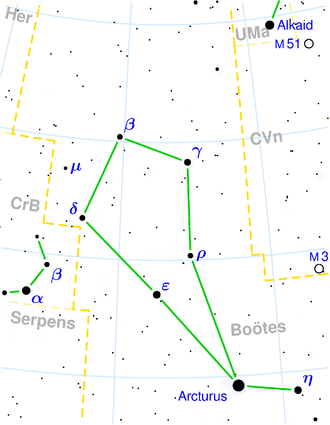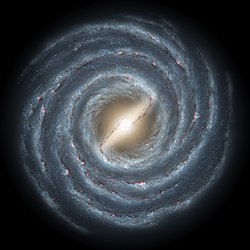Bootes-I-Zwerggalaxie
| Galaxie Bootes-I-Zwerggalaxie | |
|---|---|
| Bootes I | |
| AladinLite | |
| Sternbild | Bärenhüter |
| Position Äquinoktium: J2000.0, Epoche: J2000.0 | |
| Rektaszension | 14h 00m 06s[1] |
| Deklination | +14° 30′ 00″ [1] |
| Erscheinungsbild | |
| Morphologischer Typ | dSph [1] |
| Helligkeit (visuell) | 13,1 mag [1] |
| Winkelausdehnung | 26,0' ± 1,4' [1] |
| Physikalische Daten | |
| Zugehörigkeit | Lokale Gruppe |
| Entfernung | 197.000 ± 18.000 Lj / 60.000 ± 6.000 pc [1] |
| Absolute Helligkeit | −5,8 mag |
| Geschichte | |
| Entdeckung | Albert George Wilson |
| Entdeckungsdatum | 1950 |
| Katalogbezeichnungen | |
| Boo I dSph, Bootes Satellite, Bootes Dwarf Spheroidal Galaxy, Bootes dSph galaxy[2] | |
Die Bootes-I-Zwerggalaxie (kurz auch Bootes I oder Boo I dSph) ist eine äußerst lichtschwache spheroidale Zwerggalaxie im Sternbild des Bärenhüters und gehört somit zum Untertyp der Ultra-faint-dwarf-Galaxien.
Eigenschaften
Die Galaxie besitzt eine Leuchtkraft von nur etwa 100.000 L☉ und eine absolute Helligkeit von −5,8m. Sie ist lediglich etwa 197 kly entfernt und scheint durch Gezeitenkräfte unserer Milchstraße verformt und auseinandergerissen zu werden[1]. Dabei zeigt sie zwei Sternenschweife, die sich kreuzen. Im Normalfall formen Gezeitenkräfte nur einen Schweif bei Satellitengalaxien.
Wie die meisten der sogenannten Ultra-faint-dwarf-Galaxien ist die gesamte Galaxie lichtschwächer als der Einzelstern Rigel.
Bemerkung
Scheinbare Helligkeit = Absolute Helligkeit + Entfernungsmodul = −5,8[1] + 18,9[1] = 13,1
Weblinks
- The Universe within 500,000 light-years The Satellite Galaxies (Atlas of the Universe)
- Astronomers Find Two New Milky Way Companions (SpaceDaily) May 10, 2006
- Two New Galaxies Orbiting the Milky Way (Ken Croswell) April 19, 2006
- Strange satellite galaxies revealed around Milky Way Kimm Groshong (New Scientist) 17:00 24. April 2006
- New Milky Way companions found: SDSS-II first to view two dim dwarf galaxies (SDSS) May 8, 2006
Einzelnachweise
- ↑ a b c d e f g h Belokurov, V.; Zucker, D. B.; Evans, N. W.; Wilkinson, M. I.; Irwin, M. J.; Hodgkin, S.; Bramich, D. M.; Irwin, J. M.; Gilmore, G.; Willman, B.; Vidrih, S.; Newberg, H. J.; Wyse, R. F. G.; Fellhauer, M.; Hewett, P. C.; Cole, N.; Bell, E. F.; Beers, T. C.; Rockosi, C. M.; Yanny, B.; Grebel, E. K.; Schneider, D. P.; Lupton, R.; Barentine, J. C.; Brewington, H.; Brinkmann, J.; Harvanek, M.; Kleinman, S. J.; Krzesinski, J.; Long, D.; Nitta, A.; Smith, J. A.; Snedden, S. A.: A Faint New Milky Way Satellite in Bootes. In: The Astrophysical Journal. 647, Nr. 2, 2006, S. L111–L114. arxiv:astro-ph/0604355. bibcode:2006ApJ...647L.111B. doi:10.1086/507324.
- ↑ SIMBAD Astronomical Database. In: Results for Bootes dSph. Abgerufen am 21. November 2011.
Auf dieser Seite verwendete Medien
Caption from NASA: Like early explorers mapping the continents of our globe, astronomers are busy charting the spiral structure of our galaxy, the Milky Way. Using infrared images from NASA's Spitzer Space Telescope, scientists have discovered that the Milky Way's elegant spiral structure is dominated by just two arms wrapping off the ends of a central bar of stars. Previously, our galaxy was thought to possess four major arms.
This artist's concept illustrates the new view of the Milky Way, along with other findings presented at the 212th American Astronomical Society meeting in St. Louis, Mo. The galaxy's two major arms (Scutum-Centaurus and Perseus) can be seen attached to the ends of a thick central bar, while the two now-demoted minor arms (Norma and Sagittarius) are less distinct and located between the major arms. The major arms consist of the highest densities of both young and old stars; the minor arms are primarily filled with gas and pockets of star-forming activity.
The artist's concept also includes a new spiral arm, called the "Far-3 kiloparsec arm," discovered via a radio-telescope survey of gas in the Milky Way. This arm is shorter than the two major arms and lies along the bar of the galaxy.
Our sun lies near a small, partial arm called the Orion Arm, or Orion Spur, located between the Sagittarius and Perseus arms.



